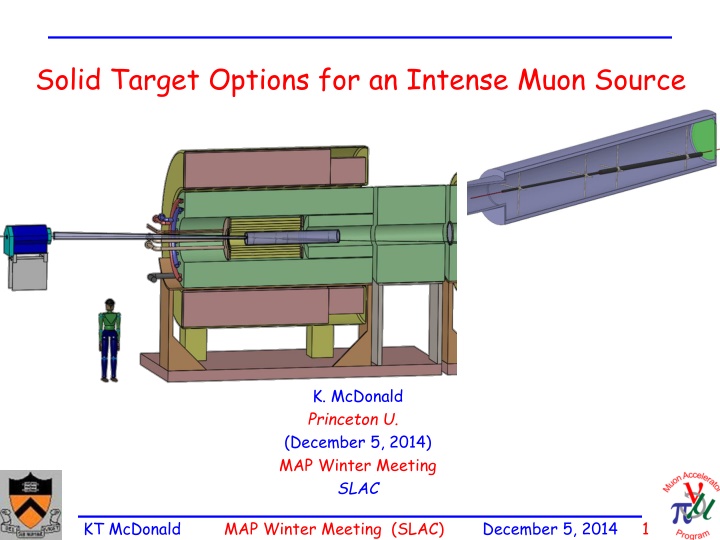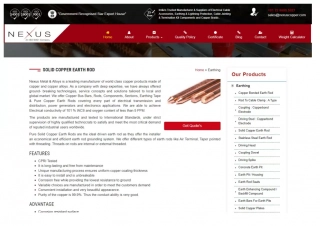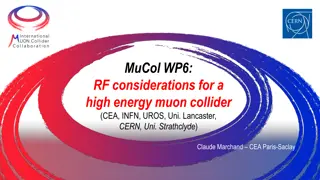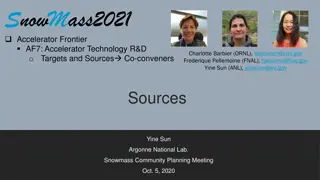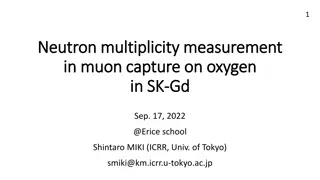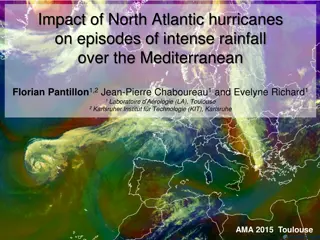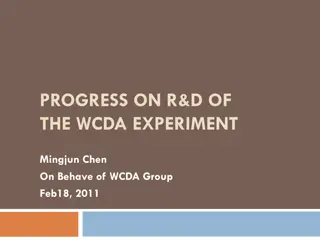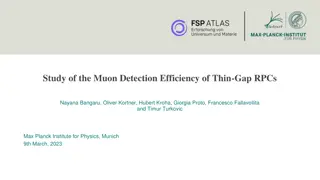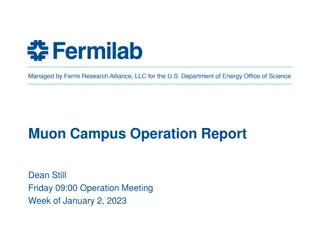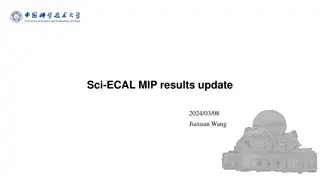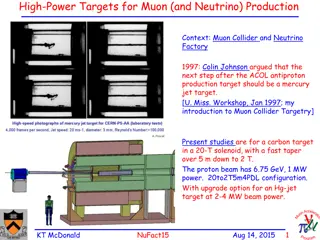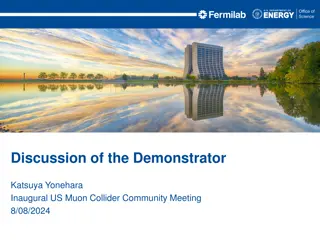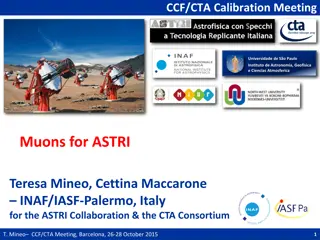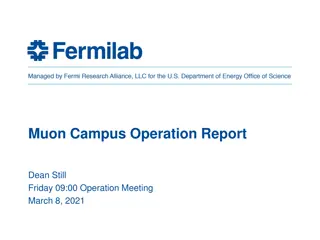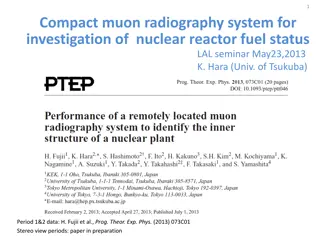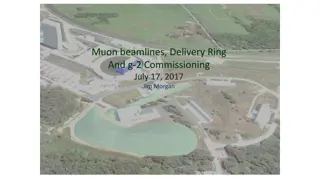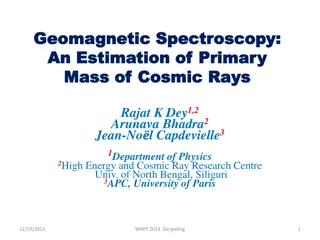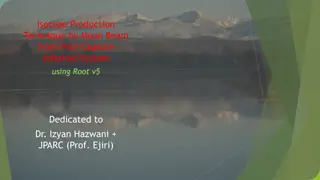Solid Target Options for an Intense Muon Source
Targeting an intense muon source for a Muon Collider and Neutrino Factory, exploring various target and capture topologies, including the use of solenoid systems, tungsten beads, and advanced superconducting magnets. Discussions on preliminary costing and the choice between liquid or solid targets for efficient beam power utilization.
Download Presentation

Please find below an Image/Link to download the presentation.
The content on the website is provided AS IS for your information and personal use only. It may not be sold, licensed, or shared on other websites without obtaining consent from the author.If you encounter any issues during the download, it is possible that the publisher has removed the file from their server.
You are allowed to download the files provided on this website for personal or commercial use, subject to the condition that they are used lawfully. All files are the property of their respective owners.
The content on the website is provided AS IS for your information and personal use only. It may not be sold, licensed, or shared on other websites without obtaining consent from the author.
E N D
Presentation Transcript
Solid Target Options for an Intense Muon Source K. McDonald Princeton U. (December 5, 2014) MAP Winter Meeting SLAC KT McDonald MAP Winter Meeting (SLAC) December 5, 2014 1
The Target System Concept A Muon Collider needs muon beams of both signs. A Neutrino Factory based on neutrinos from muon decay could operate with only one sign of muons at a time, but advantageous to have both signs. Could use two proton beams + 2 targets in solenoid horn (as per conventional neutrino beams from pion decay). Or, could use one proton beam + solenoid capture system. Fernow et al. reviewed options in March 1995, http://puhep1.princeton.edu/~mcdonald/examples/accel/fernow_aipcp_352_134_95.pdf Li lenses, plasma lenses, toroidal horns, and solenoidal capture. All of the pulsed, toroidal systems would be well beyond present technology (then and now!), so the solenoid capture system began to be favored. Fundamental issue: Power of the desired tertiary muon beam from the target is < 1% of primary proton beam power. KT McDonald MAP Winter Meeting (SLAC) December 5, 2014 2
Target and Capture Topology: Solenoid Desire 1014 /s from 1015p/s ( 4 MW proton beam) Superconducting magnets R.B. Palmer (BNL, 1994) proposed a 20 5-T solenoidal capture system. Such field taper doubles P acceptance. IDS-NF Target Concept: Tungsten beads, He gas cooled Low-energy 's collected from side of long, thin cylindrical target. Proton beam and Mercury jet Be window Solenoid coils can be some distance from proton beam. 10-year life against radiation damage at 4 MW. Mercury collection pool With splash mitigator Liquid mercury jet target replaced every pulse. Resistive magnets Proton beam readily tilted with respect to magnetic axis. Shielding of the superconducting magnets from radiation is a major issue. Magnetic stored energy ~ 3 GJ! Beam dump (mercury pool) out of the way of secondary 's and 's. 5-T copper magnet insert; 15-T Nb3Sn coil + 5-T NbTi outsert. Desirable to replace the copper magnet by a 20-T HTC insert (or 15-T Nb coil). KT McDonald MAP Winter Meeting (SLAC) December 5, 2014 3
Preliminary Costing of a 4-MW Target System The nominal target costs only a few % of the Target System. Most cost/effort deals with the 99% of the beam power that goes into other particles than muons. Infrastructure costs are ~ 50% (A. Kurup, International Design Study for a Neutrino Factory) KT McDonald MAP Winter Meeting (SLAC) December 5, 2014 4
Liquid or Solid Target? Muon Colliders/Neutrino Factories favor initial capture of low-energy muon (which are later accelerated to a desirable energy). The yield of soft pions/muons is higher for a high-Z target. Solid metal targets would melt in a MW proton beam, unless replaced ~ every beam pulse. Consider high-Z liquid metal target (He, Pb-Bi, Ga, ) or carbon target. Studies have alternated between these two options. Recent effort has emphasized carbon target options. Radiation-cooled target at high temperature may have 10 x longer lifetime against radiation damage (otherwise 1-2 weeks @ 4 MW proton beam power). KT McDonald MAP Winter Meeting (SLAC) December 5, 2014 5
Specifications from the Muon Accelerator Staging Scenario 6.75 GeV (kinetic energy) proton beam with 3 ns (rms) pulse. 1 MW initial beam power, upgradable to 2 MW (perhaps even to 4 MW). 60 Hz initial rep rate for Neutrino Factory; 15 Hz rep rate for later Muon Collider. The goal is to deliver a maximum number of soft muons, ~ 40 < KE < ~ 180 MeV. KT McDonald MAP Winter Meeting (SLAC) December 5, 2014 6
Target System Concept 15 T superconducting coil outsert, Stored energy ~ 3 GJ, ~ 100 tons Proton beam tube Last Final-Focus quad Stainless-steel target vessel (double-walled with intramural He-gas flow for cooling) with graphite target and beam dump, and downstream Be window. This vessel would be replaced every few months at 1 MW beam power. Upstream proton beam window 5 T copper-coil insert. Water-cooled, MgO insulated He-gas cooled W-bead shielding (~ 100 tons) KT McDonald MAP Winter Meeting (SLAC) December 5, 2014 7
Target System Optimization (Ding) for fixed geometric, rms transverse emittance of 5 m Taper Optimization (Sayed) KT McDonald MAP Winter Meeting (SLAC) December 5, 2014 8
Target System Optimizations High-Z favored. Optima for graphite target (Ding): length = 80 cm, radius ~ 8 mm (with r = 2 mm (rms) beam radius), tilt angle = 65 mrad, nominal geometric rms emittance = 5 m. * = r2 / = 0.8 m. Graphite proton beam dump, 120 cm long, 24 mm radius to intercept most of the (diverging) unscattered proton beam. The 20 T field on target should drop to the ~ 2 T field in the rest of the Front End over ~ 5 m (Sayed; but not verified when using graphite dump). However, difficult to deliver a beam of 5 m emittance with over 1 MW power. KT McDonald MAP Winter Meeting (SLAC) December 5, 2014 9
Target System Optimization for variable geometric, rms transverse emittance No tilt of beam/target 65 mrad tilt of beam/target We prefer target radius 8 mm (beam radius 2 mm) for viable radiation cooling of the target. Yield for 50 m emittance and target radius of 1.2 cm is only 10% less than that for the nominal case of 5 m emittance an 0.8 cm target radius. For rtarget = 8 mm, same yield for any emittance 20 m. Little loss of muon yield for 20 m emittance (compared to 5 m), Can use single beam @ 4 MW. KT McDonald MAP Winter Meeting (SLAC) December 5, 2014 10
Extending Target System Studies to the Chicane A chicane is proposed to suppress the 10% of the beam energy that goes into slightly scattered protons. (Graves: Using the loft feature in SolidWorks) (Weggel: COMSOL) Beam envelope inside the chicane morphs from circle to ellipse and back to circle. Beampipe could/should follow this. To be studied: Outer radius of shield needed to protect superconducting coils. Propose small budget for Bob Weggel to make coil iterations and field maps. Can we add the loft feature to ROOT geometry? KT McDonald MAP Winter Meeting (SLAC) December 5, 2014 11
Future Target R&D Muon Collider/Neutrino Factory studies in the USA being ramped down. Interest remains in high-power targetry for various applications. See, for example, the 5th High Power Targetry Workshop (FNAL, 2014), https://indico.fnal.gov/conferenceDisplay.py?ovw=True&confId=7870 [These workshops were initiated by H. Kirk.] A particular issue: how much beam power can a graphite target stand? Lifetime against radiation damage much better at high temperature. (Might be several months @ 4 MW beam power, tho only 1-2 weeks at room temperature .) Resistance to thermal shock from pulsed beams also better at high temperature. Firm up these trends with data from beam irradiations of high-temperature graphite. (The Muon Collider/Neutrino Factory group participated in beam irradiations of water-cooled graphite and many other target materials in 2002-2006.) GARD proposal(s) being generated by BNL and FNAL for such studies. New diagnostic: x-ray diffraction of irradiated samples. KT McDonald MAP Winter Meeting (SLAC) December 5, 2014 12
